Audit and Assurance Report: Materiality, Independence and Ethics
VerifiedAdded on 2022/10/09
|7
|1506
|23
Report
AI Summary
This assignment report examines key aspects of audit and assurance, focusing on the evolution of AASB 1031, which addressed materiality. The report traces the changes in the standard from its inception in 1995 to its withdrawal in 2015, highlighting the shift towards alignment with international accounting standards. It also defines materiality and explains how auditors assess it, including the quantitative and qualitative considerations before the withdrawal of AASB 1031. Furthermore, the report discusses the importance of auditor independence, differentiating between real and perceived independence, and analyzing ethical breaches in various scenarios involving confidentiality and conflicts of interest. It emphasizes the impact of these breaches on the integrity of the audit process. Finally, the report considers the implications of removing specific materiality guidance, addressing potential inconsistencies in auditor judgments.
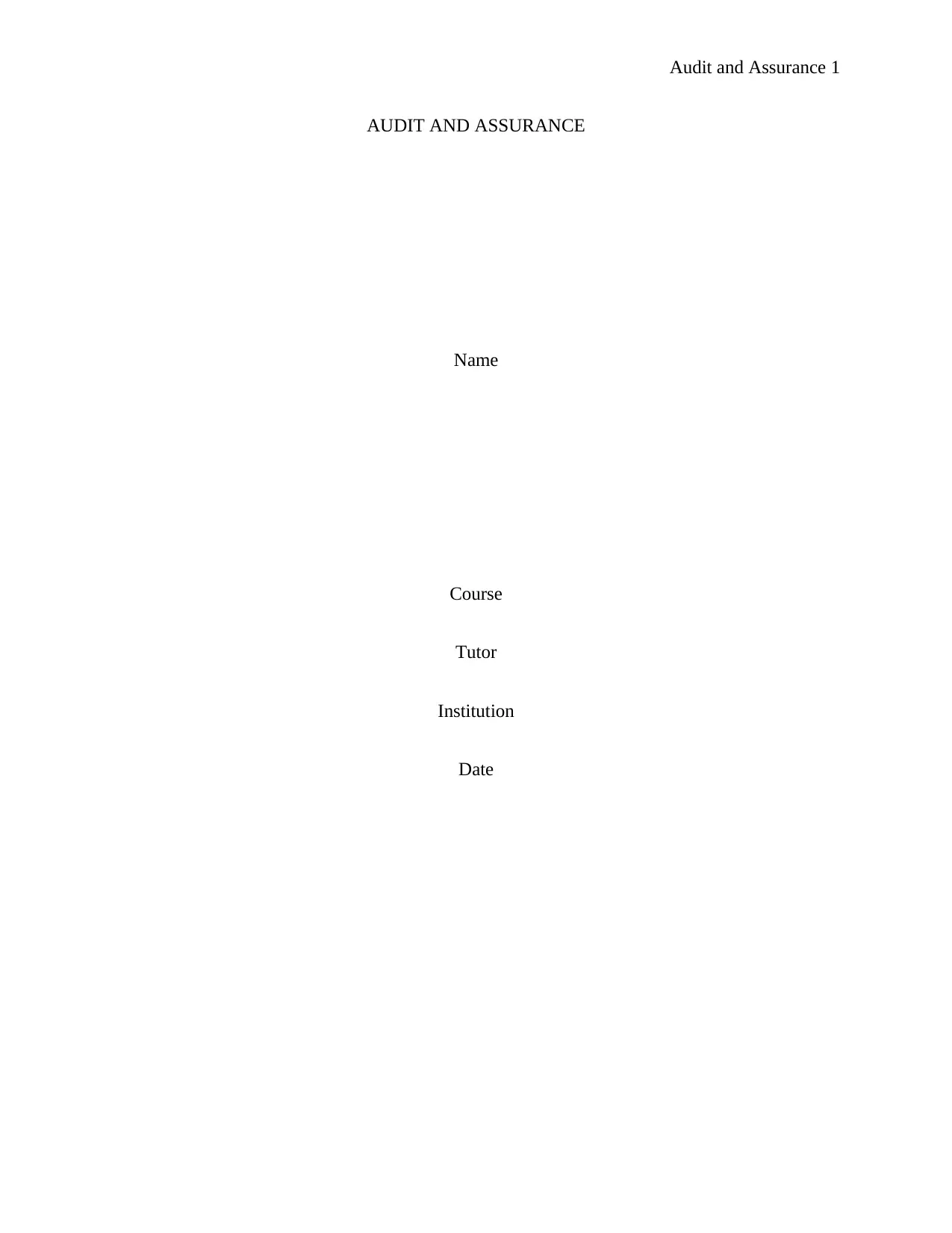
Audit and Assurance 1
AUDIT AND ASSURANCE
Name
Course
Tutor
Institution
Date
AUDIT AND ASSURANCE
Name
Course
Tutor
Institution
Date
Paraphrase This Document
Need a fresh take? Get an instant paraphrase of this document with our AI Paraphraser
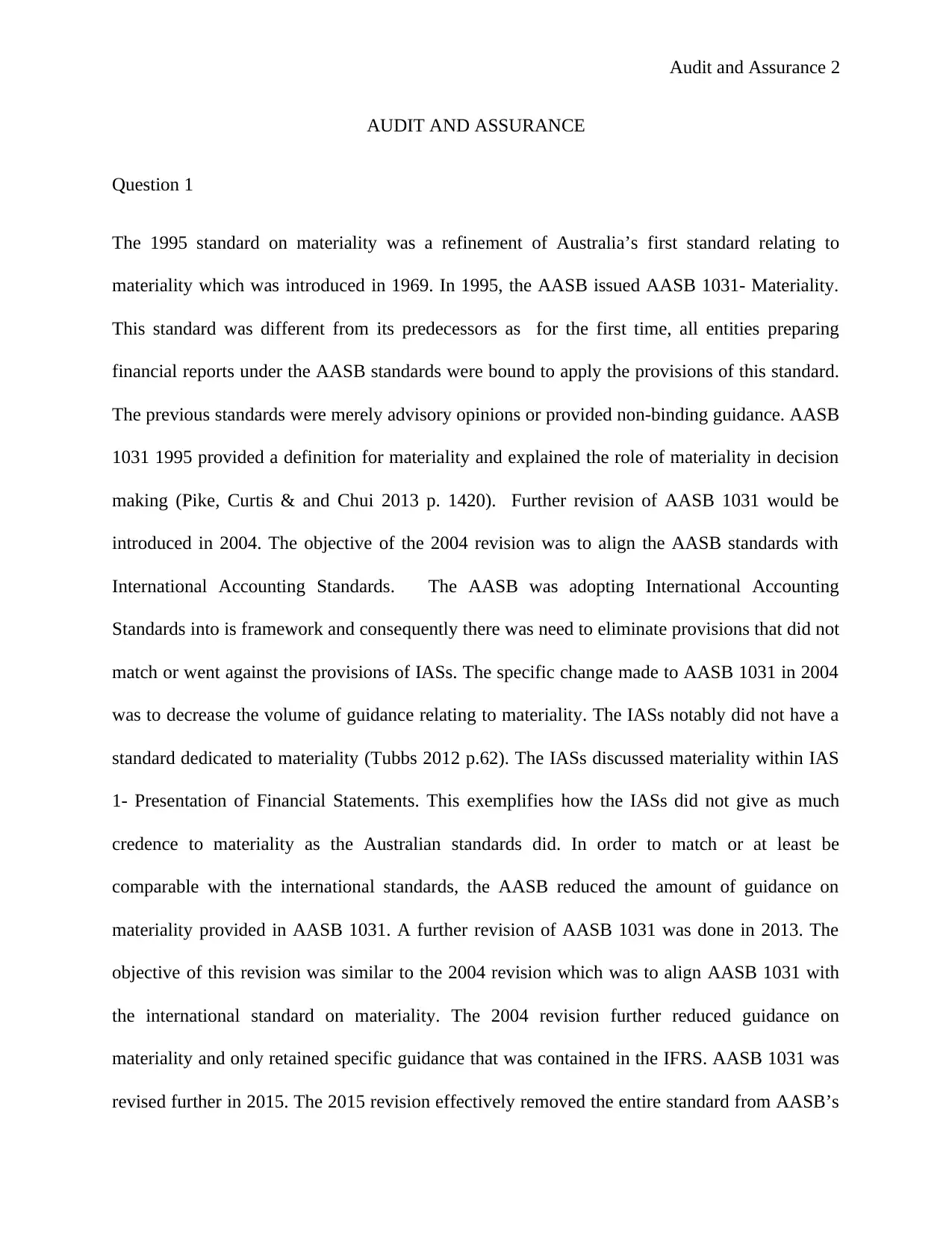
Audit and Assurance 2
AUDIT AND ASSURANCE
Question 1
The 1995 standard on materiality was a refinement of Australia’s first standard relating to
materiality which was introduced in 1969. In 1995, the AASB issued AASB 1031- Materiality.
This standard was different from its predecessors as for the first time, all entities preparing
financial reports under the AASB standards were bound to apply the provisions of this standard.
The previous standards were merely advisory opinions or provided non-binding guidance. AASB
1031 1995 provided a definition for materiality and explained the role of materiality in decision
making (Pike, Curtis & and Chui 2013 p. 1420). Further revision of AASB 1031 would be
introduced in 2004. The objective of the 2004 revision was to align the AASB standards with
International Accounting Standards. The AASB was adopting International Accounting
Standards into is framework and consequently there was need to eliminate provisions that did not
match or went against the provisions of IASs. The specific change made to AASB 1031 in 2004
was to decrease the volume of guidance relating to materiality. The IASs notably did not have a
standard dedicated to materiality (Tubbs 2012 p.62). The IASs discussed materiality within IAS
1- Presentation of Financial Statements. This exemplifies how the IASs did not give as much
credence to materiality as the Australian standards did. In order to match or at least be
comparable with the international standards, the AASB reduced the amount of guidance on
materiality provided in AASB 1031. A further revision of AASB 1031 was done in 2013. The
objective of this revision was similar to the 2004 revision which was to align AASB 1031 with
the international standard on materiality. The 2004 revision further reduced guidance on
materiality and only retained specific guidance that was contained in the IFRS. AASB 1031 was
revised further in 2015. The 2015 revision effectively removed the entire standard from AASB’s
AUDIT AND ASSURANCE
Question 1
The 1995 standard on materiality was a refinement of Australia’s first standard relating to
materiality which was introduced in 1969. In 1995, the AASB issued AASB 1031- Materiality.
This standard was different from its predecessors as for the first time, all entities preparing
financial reports under the AASB standards were bound to apply the provisions of this standard.
The previous standards were merely advisory opinions or provided non-binding guidance. AASB
1031 1995 provided a definition for materiality and explained the role of materiality in decision
making (Pike, Curtis & and Chui 2013 p. 1420). Further revision of AASB 1031 would be
introduced in 2004. The objective of the 2004 revision was to align the AASB standards with
International Accounting Standards. The AASB was adopting International Accounting
Standards into is framework and consequently there was need to eliminate provisions that did not
match or went against the provisions of IASs. The specific change made to AASB 1031 in 2004
was to decrease the volume of guidance relating to materiality. The IASs notably did not have a
standard dedicated to materiality (Tubbs 2012 p.62). The IASs discussed materiality within IAS
1- Presentation of Financial Statements. This exemplifies how the IASs did not give as much
credence to materiality as the Australian standards did. In order to match or at least be
comparable with the international standards, the AASB reduced the amount of guidance on
materiality provided in AASB 1031. A further revision of AASB 1031 was done in 2013. The
objective of this revision was similar to the 2004 revision which was to align AASB 1031 with
the international standard on materiality. The 2004 revision further reduced guidance on
materiality and only retained specific guidance that was contained in the IFRS. AASB 1031 was
revised further in 2015. The 2015 revision effectively removed the entire standard from AASB’s
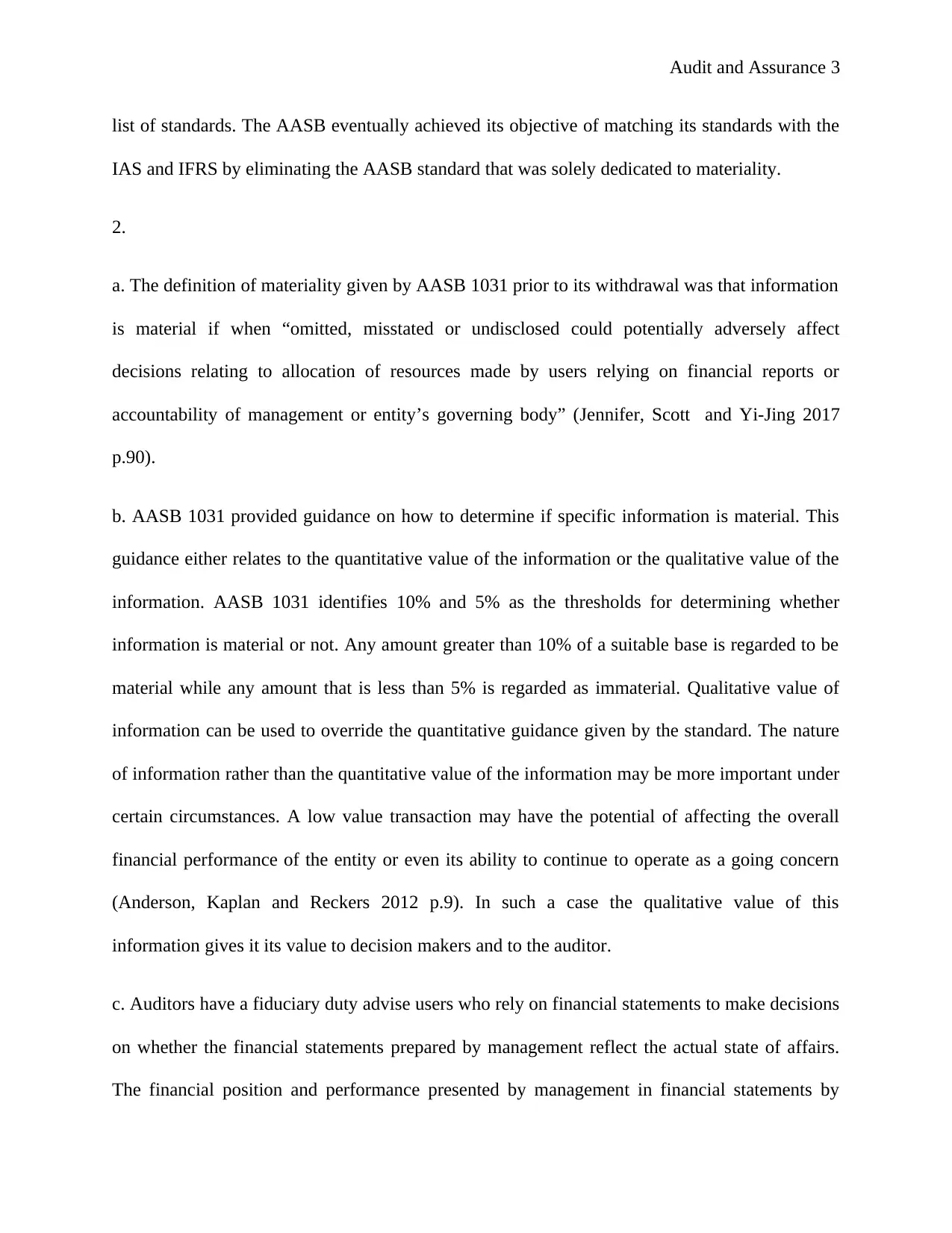
Audit and Assurance 3
list of standards. The AASB eventually achieved its objective of matching its standards with the
IAS and IFRS by eliminating the AASB standard that was solely dedicated to materiality.
2.
a. The definition of materiality given by AASB 1031 prior to its withdrawal was that information
is material if when “omitted, misstated or undisclosed could potentially adversely affect
decisions relating to allocation of resources made by users relying on financial reports or
accountability of management or entity’s governing body” (Jennifer, Scott and Yi-Jing 2017
p.90).
b. AASB 1031 provided guidance on how to determine if specific information is material. This
guidance either relates to the quantitative value of the information or the qualitative value of the
information. AASB 1031 identifies 10% and 5% as the thresholds for determining whether
information is material or not. Any amount greater than 10% of a suitable base is regarded to be
material while any amount that is less than 5% is regarded as immaterial. Qualitative value of
information can be used to override the quantitative guidance given by the standard. The nature
of information rather than the quantitative value of the information may be more important under
certain circumstances. A low value transaction may have the potential of affecting the overall
financial performance of the entity or even its ability to continue to operate as a going concern
(Anderson, Kaplan and Reckers 2012 p.9). In such a case the qualitative value of this
information gives it its value to decision makers and to the auditor.
c. Auditors have a fiduciary duty advise users who rely on financial statements to make decisions
on whether the financial statements prepared by management reflect the actual state of affairs.
The financial position and performance presented by management in financial statements by
list of standards. The AASB eventually achieved its objective of matching its standards with the
IAS and IFRS by eliminating the AASB standard that was solely dedicated to materiality.
2.
a. The definition of materiality given by AASB 1031 prior to its withdrawal was that information
is material if when “omitted, misstated or undisclosed could potentially adversely affect
decisions relating to allocation of resources made by users relying on financial reports or
accountability of management or entity’s governing body” (Jennifer, Scott and Yi-Jing 2017
p.90).
b. AASB 1031 provided guidance on how to determine if specific information is material. This
guidance either relates to the quantitative value of the information or the qualitative value of the
information. AASB 1031 identifies 10% and 5% as the thresholds for determining whether
information is material or not. Any amount greater than 10% of a suitable base is regarded to be
material while any amount that is less than 5% is regarded as immaterial. Qualitative value of
information can be used to override the quantitative guidance given by the standard. The nature
of information rather than the quantitative value of the information may be more important under
certain circumstances. A low value transaction may have the potential of affecting the overall
financial performance of the entity or even its ability to continue to operate as a going concern
(Anderson, Kaplan and Reckers 2012 p.9). In such a case the qualitative value of this
information gives it its value to decision makers and to the auditor.
c. Auditors have a fiduciary duty advise users who rely on financial statements to make decisions
on whether the financial statements prepared by management reflect the actual state of affairs.
The financial position and performance presented by management in financial statements by
⊘ This is a preview!⊘
Do you want full access?
Subscribe today to unlock all pages.

Trusted by 1+ million students worldwide
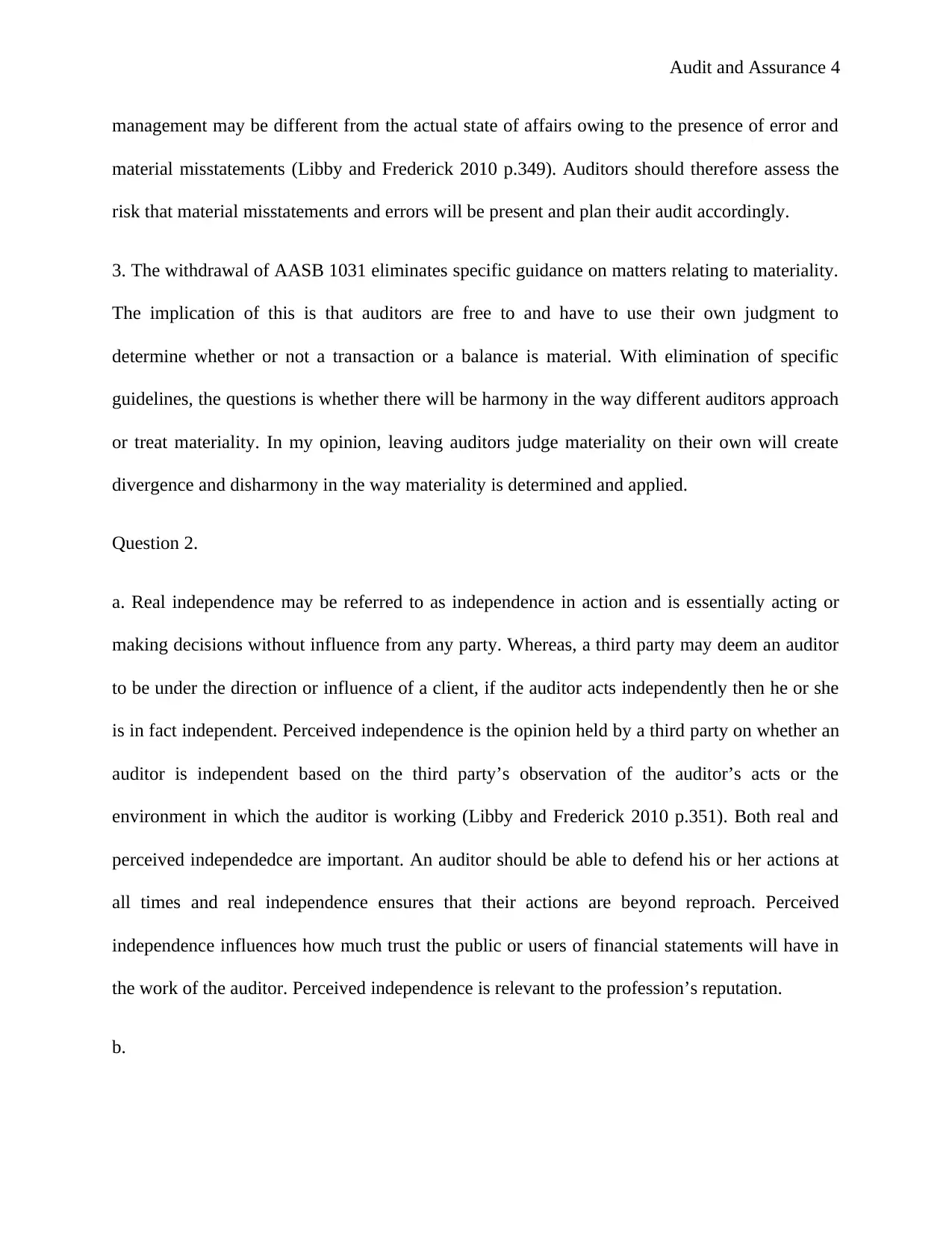
Audit and Assurance 4
management may be different from the actual state of affairs owing to the presence of error and
material misstatements (Libby and Frederick 2010 p.349). Auditors should therefore assess the
risk that material misstatements and errors will be present and plan their audit accordingly.
3. The withdrawal of AASB 1031 eliminates specific guidance on matters relating to materiality.
The implication of this is that auditors are free to and have to use their own judgment to
determine whether or not a transaction or a balance is material. With elimination of specific
guidelines, the questions is whether there will be harmony in the way different auditors approach
or treat materiality. In my opinion, leaving auditors judge materiality on their own will create
divergence and disharmony in the way materiality is determined and applied.
Question 2.
a. Real independence may be referred to as independence in action and is essentially acting or
making decisions without influence from any party. Whereas, a third party may deem an auditor
to be under the direction or influence of a client, if the auditor acts independently then he or she
is in fact independent. Perceived independence is the opinion held by a third party on whether an
auditor is independent based on the third party’s observation of the auditor’s acts or the
environment in which the auditor is working (Libby and Frederick 2010 p.351). Both real and
perceived independedce are important. An auditor should be able to defend his or her actions at
all times and real independence ensures that their actions are beyond reproach. Perceived
independence influences how much trust the public or users of financial statements will have in
the work of the auditor. Perceived independence is relevant to the profession’s reputation.
b.
management may be different from the actual state of affairs owing to the presence of error and
material misstatements (Libby and Frederick 2010 p.349). Auditors should therefore assess the
risk that material misstatements and errors will be present and plan their audit accordingly.
3. The withdrawal of AASB 1031 eliminates specific guidance on matters relating to materiality.
The implication of this is that auditors are free to and have to use their own judgment to
determine whether or not a transaction or a balance is material. With elimination of specific
guidelines, the questions is whether there will be harmony in the way different auditors approach
or treat materiality. In my opinion, leaving auditors judge materiality on their own will create
divergence and disharmony in the way materiality is determined and applied.
Question 2.
a. Real independence may be referred to as independence in action and is essentially acting or
making decisions without influence from any party. Whereas, a third party may deem an auditor
to be under the direction or influence of a client, if the auditor acts independently then he or she
is in fact independent. Perceived independence is the opinion held by a third party on whether an
auditor is independent based on the third party’s observation of the auditor’s acts or the
environment in which the auditor is working (Libby and Frederick 2010 p.351). Both real and
perceived independedce are important. An auditor should be able to defend his or her actions at
all times and real independence ensures that their actions are beyond reproach. Perceived
independence influences how much trust the public or users of financial statements will have in
the work of the auditor. Perceived independence is relevant to the profession’s reputation.
b.
Paraphrase This Document
Need a fresh take? Get an instant paraphrase of this document with our AI Paraphraser
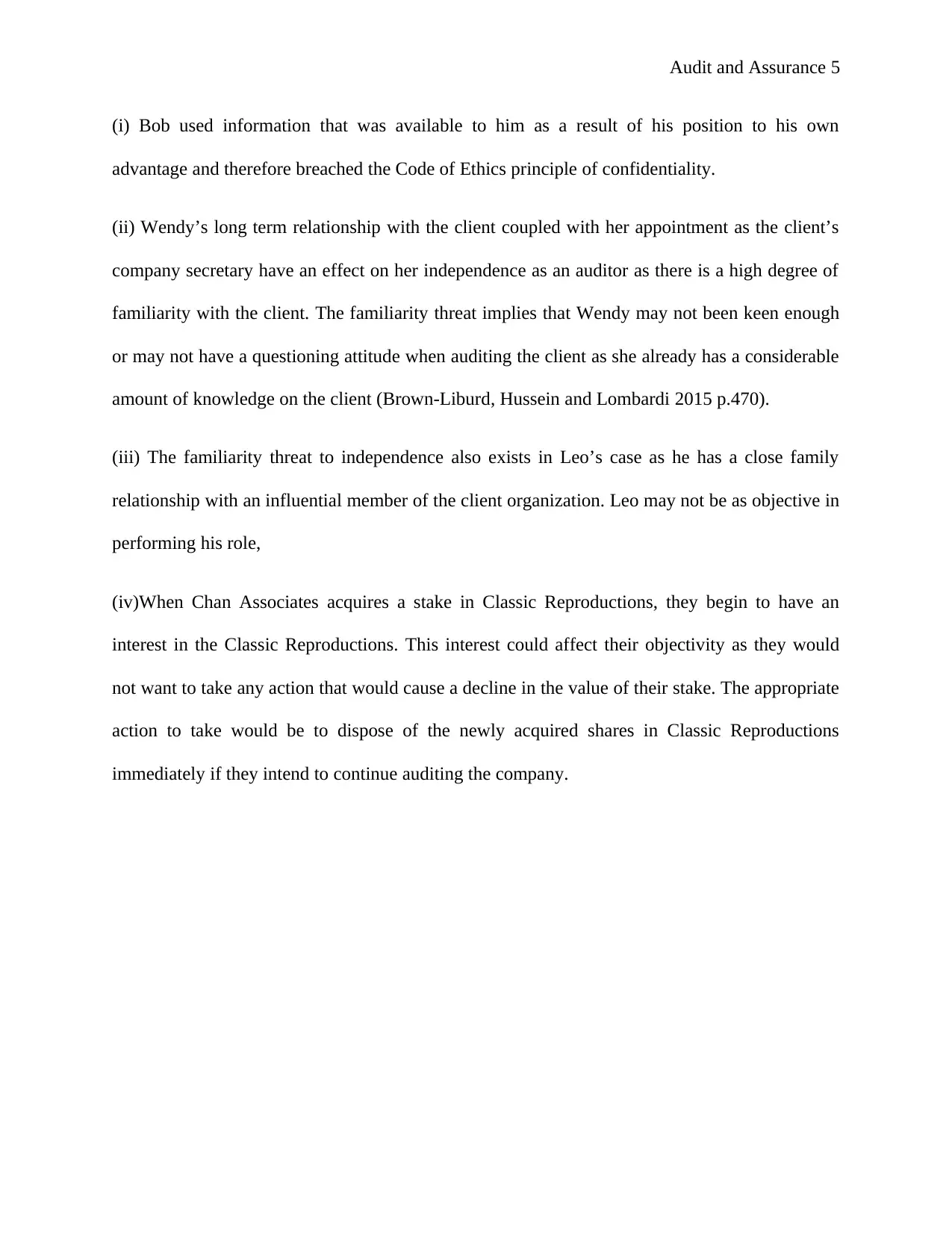
Audit and Assurance 5
(i) Bob used information that was available to him as a result of his position to his own
advantage and therefore breached the Code of Ethics principle of confidentiality.
(ii) Wendy’s long term relationship with the client coupled with her appointment as the client’s
company secretary have an effect on her independence as an auditor as there is a high degree of
familiarity with the client. The familiarity threat implies that Wendy may not been keen enough
or may not have a questioning attitude when auditing the client as she already has a considerable
amount of knowledge on the client (Brown-Liburd, Hussein and Lombardi 2015 p.470).
(iii) The familiarity threat to independence also exists in Leo’s case as he has a close family
relationship with an influential member of the client organization. Leo may not be as objective in
performing his role,
(iv)When Chan Associates acquires a stake in Classic Reproductions, they begin to have an
interest in the Classic Reproductions. This interest could affect their objectivity as they would
not want to take any action that would cause a decline in the value of their stake. The appropriate
action to take would be to dispose of the newly acquired shares in Classic Reproductions
immediately if they intend to continue auditing the company.
(i) Bob used information that was available to him as a result of his position to his own
advantage and therefore breached the Code of Ethics principle of confidentiality.
(ii) Wendy’s long term relationship with the client coupled with her appointment as the client’s
company secretary have an effect on her independence as an auditor as there is a high degree of
familiarity with the client. The familiarity threat implies that Wendy may not been keen enough
or may not have a questioning attitude when auditing the client as she already has a considerable
amount of knowledge on the client (Brown-Liburd, Hussein and Lombardi 2015 p.470).
(iii) The familiarity threat to independence also exists in Leo’s case as he has a close family
relationship with an influential member of the client organization. Leo may not be as objective in
performing his role,
(iv)When Chan Associates acquires a stake in Classic Reproductions, they begin to have an
interest in the Classic Reproductions. This interest could affect their objectivity as they would
not want to take any action that would cause a decline in the value of their stake. The appropriate
action to take would be to dispose of the newly acquired shares in Classic Reproductions
immediately if they intend to continue auditing the company.
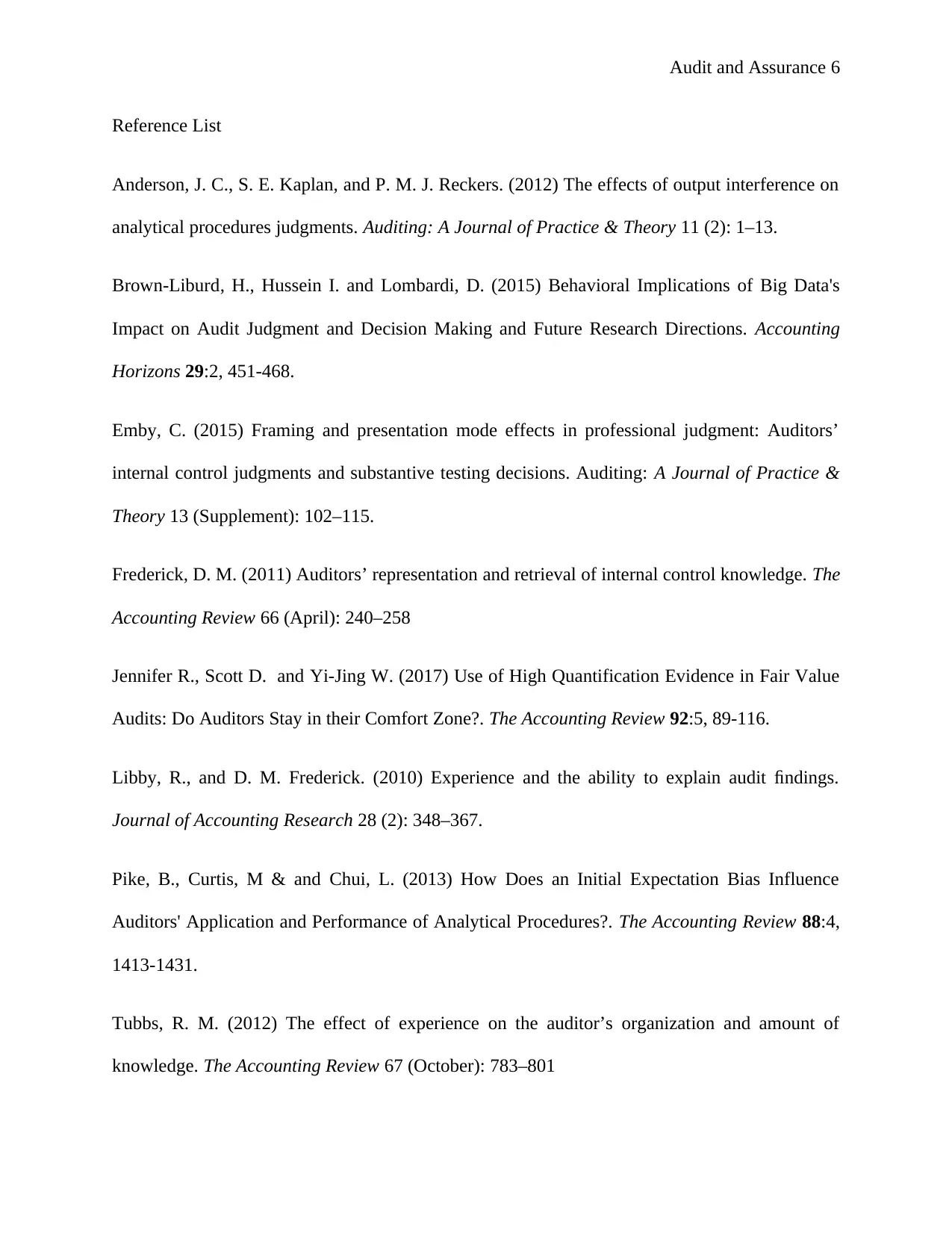
Audit and Assurance 6
Reference List
Anderson, J. C., S. E. Kaplan, and P. M. J. Reckers. (2012) The effects of output interference on
analytical procedures judgments. Auditing: A Journal of Practice & Theory 11 (2): 1–13.
Brown-Liburd, H., Hussein I. and Lombardi, D. (2015) Behavioral Implications of Big Data's
Impact on Audit Judgment and Decision Making and Future Research Directions. Accounting
Horizons 29:2, 451-468.
Emby, C. (2015) Framing and presentation mode effects in professional judgment: Auditors’
internal control judgments and substantive testing decisions. Auditing: A Journal of Practice &
Theory 13 (Supplement): 102–115.
Frederick, D. M. (2011) Auditors’ representation and retrieval of internal control knowledge. The
Accounting Review 66 (April): 240–258
Jennifer R., Scott D. and Yi-Jing W. (2017) Use of High Quantification Evidence in Fair Value
Audits: Do Auditors Stay in their Comfort Zone?. The Accounting Review 92:5, 89-116.
Libby, R., and D. M. Frederick. (2010) Experience and the ability to explain audit findings.
Journal of Accounting Research 28 (2): 348–367.
Pike, B., Curtis, M & and Chui, L. (2013) How Does an Initial Expectation Bias Influence
Auditors' Application and Performance of Analytical Procedures?. The Accounting Review 88:4,
1413-1431.
Tubbs, R. M. (2012) The effect of experience on the auditor’s organization and amount of
knowledge. The Accounting Review 67 (October): 783–801
Reference List
Anderson, J. C., S. E. Kaplan, and P. M. J. Reckers. (2012) The effects of output interference on
analytical procedures judgments. Auditing: A Journal of Practice & Theory 11 (2): 1–13.
Brown-Liburd, H., Hussein I. and Lombardi, D. (2015) Behavioral Implications of Big Data's
Impact on Audit Judgment and Decision Making and Future Research Directions. Accounting
Horizons 29:2, 451-468.
Emby, C. (2015) Framing and presentation mode effects in professional judgment: Auditors’
internal control judgments and substantive testing decisions. Auditing: A Journal of Practice &
Theory 13 (Supplement): 102–115.
Frederick, D. M. (2011) Auditors’ representation and retrieval of internal control knowledge. The
Accounting Review 66 (April): 240–258
Jennifer R., Scott D. and Yi-Jing W. (2017) Use of High Quantification Evidence in Fair Value
Audits: Do Auditors Stay in their Comfort Zone?. The Accounting Review 92:5, 89-116.
Libby, R., and D. M. Frederick. (2010) Experience and the ability to explain audit findings.
Journal of Accounting Research 28 (2): 348–367.
Pike, B., Curtis, M & and Chui, L. (2013) How Does an Initial Expectation Bias Influence
Auditors' Application and Performance of Analytical Procedures?. The Accounting Review 88:4,
1413-1431.
Tubbs, R. M. (2012) The effect of experience on the auditor’s organization and amount of
knowledge. The Accounting Review 67 (October): 783–801
⊘ This is a preview!⊘
Do you want full access?
Subscribe today to unlock all pages.

Trusted by 1+ million students worldwide
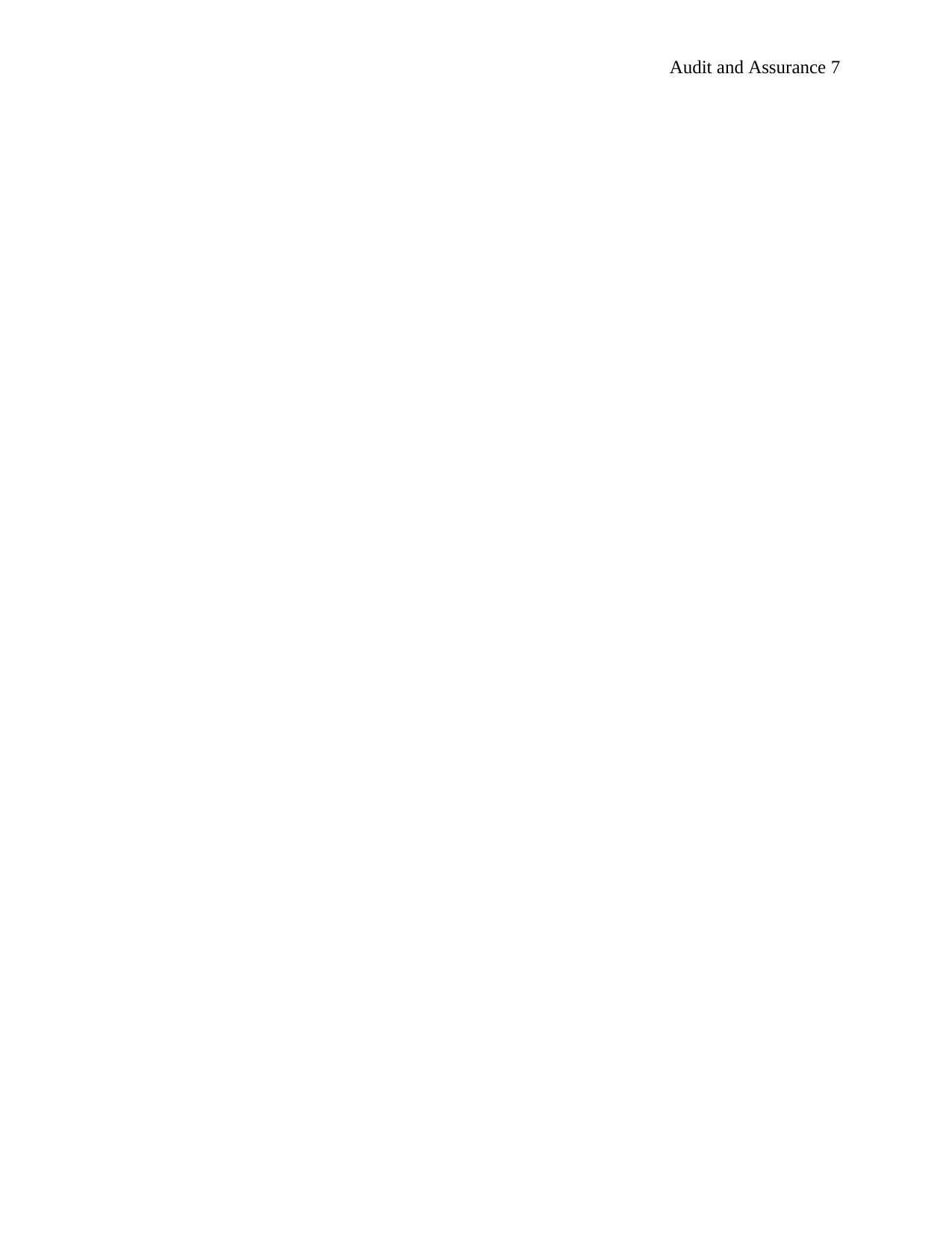
Audit and Assurance 7
1 out of 7
Related Documents
Your All-in-One AI-Powered Toolkit for Academic Success.
+13062052269
info@desklib.com
Available 24*7 on WhatsApp / Email
![[object Object]](/_next/static/media/star-bottom.7253800d.svg)
Unlock your academic potential
Copyright © 2020–2025 A2Z Services. All Rights Reserved. Developed and managed by ZUCOL.



